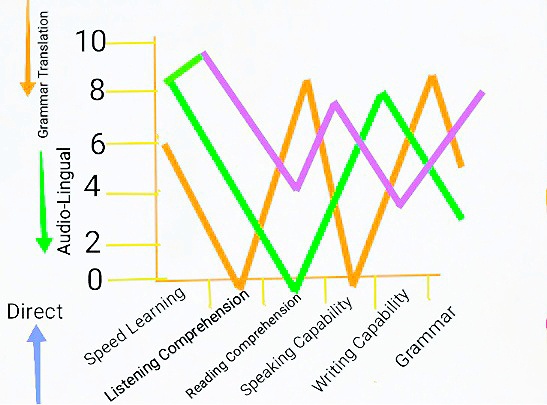What is The Best Language Teaching Method

There are six ways to dominate the language learning business: Direct method, grammar- translation method and audio-linguistic method. It is difficult to decide which method is best because everyone has strengths and weaknesses and the nature of a student's goals will determine what is best for that student. Although many language-learning sources can talk about exclusive or unique methods, they are using one of these three methods with few exceptions. We have done extensive research on teaching methods for our online language training programs.
Here is an analysis of the strengths and weaknesses of each, as well as a description of the six basic English language learning methods:
- The direct method
- The grammar- translation method
- The Audio-Lingual method
- Comparing the language training methods
- Modern teaching methods
- Join the club
1. The Direct Method
If you've ever heard of direct method teaching, you've probably mistaken it for some kind of military drill, not too far back since it was first established in the early 1900s to help communicate troops in France and Germany. Fast second language.Also known as direct method and natural method of teaching English. It's used to teach a number of languages, not just English, and the basic idea of the direct method is that it uses only the target language that students are trying to learn.
Its main focus is verbal skills and it is taught through repeated drilling. Grammar is taught using persuasive methods and students need to try and guess the rules through the teacher’s oral presentation. The most popular forms of direct method today are Callan and Berlitz.
2. The Grammar- Translation Method
As the name implies, this method of teaching English is grammatically heavy and relies heavily on translation. It is a conventional or ‘classical’ method of learning a language and is still used when learning some languages. Some countries prefer this teaching style and the main idea behind this method is that students can learn all the rules of grammar, so they are able to translate several sentences. This is especially true for students who are interested in studying literature at a deeper level.3. The Audio- Lingual Method
The audio-linguistic method is based on a behavioral theory otherwise known as the new key method or military method that things are able to learn by constant reinforcement. However, when someone like the military behaves badly (or in this case misuses English), the student reacts negatively and vice versa when a student shows good use of English.It is directly related to the method and like the predecessor it uses only the target language. The biggest difference between the audio linguistic method and the direct method is that the focus of its teaching focuses on direct methods of teaching vocabulary where the audio linguistic method focuses on teaching specific grammar.
4. Comparing The Language Training Methods
This comparative graph shows the expected results for the average student at the same time, and for applying the same amount of motivation. We achieved values for each approach from 1 to 10 in the following aspects: learning speed, hearing comprehension, speech ability, writing ability, and grammar.
Encouraged to be creative during practice, the direct method gives the student the ability to communicate quickly. It gives a wide range of abilities to understand what the other person is saying to you and to develop your ability to speak. This is the preferred method of instruction with a live instructor and where speaking and listening are most important.
The grammar- translation method requires a lot of time for the student to understand the structure of the language. It suffers from hearing and speaking. Structure is helpful in understanding and especially writing. Emphasis is placed across grammar and vocabulary. The goal of the student is to acquire a high level of writing and reading skills in a foreign language, versus speaking and listening.
The audio- linguistic approach allows peaks to communicate quickly but has a limited range of repetitions. If the speaker uses phrases that the student has studied, it improves comprehension. Reading is limited, and understanding of how to use language is extremely limited. This method is used when Live Trainer is not available.
So, you can go this link English Grammar Rules.
5. Modern Teaching Methods
As mentioned above, the modern language teacher does not follow a rigid method, but applies a policy eclectic approach- the method is suitable for the student, not the other way around.This means focusing on inspiration for each strategy, context, and student, and choosing strategies and activities that help students become motivated and inspired to learn more.
The policy summary explanation includes an effective ten- point guide to the best teaching and learning strategies for teachers and language learners.
6. Join The Club
Let's all go to the conversation club now. Don't you have Okay, however, start one-every Thursday from 2pm to 2:30 pm or the time, day and duration that may suit you and your students. The key is to give them a majority of control or at least as much as possible. Use crops, use realities, use pictures, use music or whatever you and your students have to start, stop and sustain activities.Other "Clubs" You Can Join Include
- Pronunciation clubs
- Reading clubs
- Cinema and theater
- Acting Club
Use the imagination of you and your students. Sky Limit- or Sky Administration Limit. No matter, try something new to get started.
Try some of these unused-commonly-used techniques to add "new twists" to your English or foreign language class. Give your peaks something new to release from any monotony and increase their interest. Can't you just read those influential filters now?

No comments:
Post a Comment